Cuba, Que Linda Es Cuba – Quien La defiende, la quiere mas!
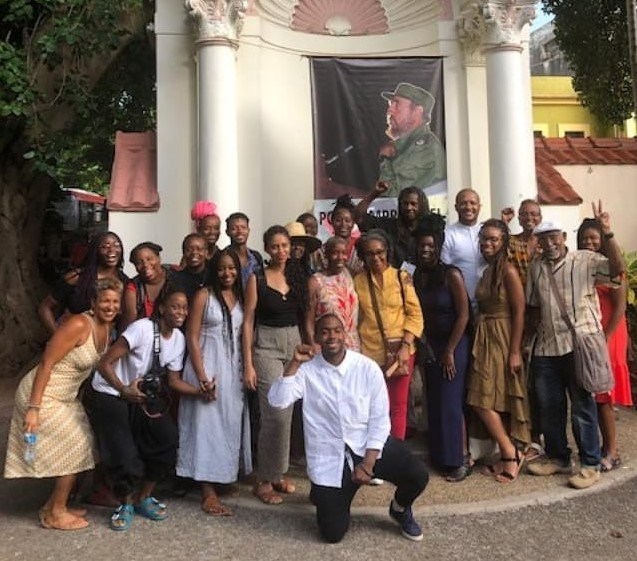
Cuba, Que Linda Es Cuba
by Michael Novick, Anti-Racist Action LA
I went to Cuba for the first time, as part of the 50th Venceremos Brigade, for two weeks in July and August, along with over 150 others, the largest solidarity delegation in many years.

The visit was eye-opening about the on-going revolutionary process and humanitarian values of their socialist society. It inspired us to oppose the US embargo/blockade against Cuba, and to organize to demand that the US recognize and respect Cuban sovereignty and dignity, stop trying to overthrow its government and punish its people, and return Guantanamo to Cuba. This Brigade marked the anniversary of the first in 1969, when over 200 mostly young US radicals, inspired by Fidel Castro’s call to help with a harvest of 10 million tons of sugar cane, went to the island nation in the first international solidarity contingent from any country. At that time, the Cuban economy was already being damaged by a strangling economic embargo the US had imposed under Eisenhower in 1960, and continued by Kennedy, Johnson and Nixon. The Brigade has returned annually to work with and learn from the Cuban people and defy the US travel bans.
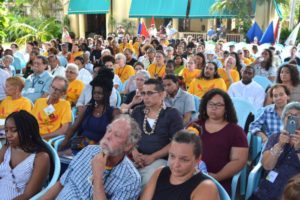
My overwhelming impression of the Cuban people is about the extent of their caring, and the care they take. They care for each other and for their environment, and they take great care in their processes, economic development and various projects. They pay attention to each step and aspect and its impact on people and on nature. Most of the farms, whether state owned, cooperative or private, are organic. Despite the longstanding US animosity and blockade and their limited resources, there is little to no unemployment or houselessness. All medical and dental care is provided free of charge, including in vitro fertilization and even gender-reassignment surgery. Education is free even through advanced post-secondary and post-graduate levels, such as in medicine. People are guaranteed a basic nutritious diet. 75-90% of workers in private or state enterprises are in labor unions. In all these respects, despite its much lower per capita income, revolutionary Cuba compares favorably to the USA, where millions live on the streets and suffer from hunger or “food insecurity,” people are dying from lack of medical care, workers are commonly without union protection and in precarious “gig economy” jobs or the “grey market,” and mass incarceration impacts millions directly and millions more through their families.
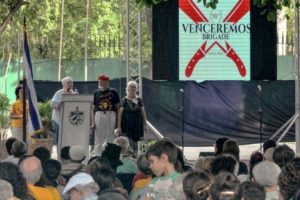
Cuba is a beautiful, verdant and dynamic island nation, about the size of Florida but with only 11 million people. It is still predominantly rural and agricultural, although there are several large cities, including the capital, Havana, with about a million residents. The countryside is fairly sparsely populated, and especially because of the US embargo/blockade of Cuba, and Trump’s new attacks on Venezuela, petroleum is at a premium. Many Cubans travel on motor-scooters, horse-and-buggy, bicycles and pedicabs.
Despite common assumptions in the US that Cuba is a police state, with people being spied on or constantly harangued by government or Communist Party propaganda, police were a rarity as we traveled around, and those we saw, including those providing an escort for our buses, were friendly and unobtrusive. There were few billboards of any kind in most of the places we freely traveled to, with the exception of near historic sites and memorials to events and martyrs of the revolution. Cubans are broadly (but not uniformly) committed to a revolutionary process, and turn out in the millions for revolutionary commemorations and holidays like May Day, but day to day, they are not bombarded with revolutionary exhortations or ideological directives. And of course, there are blessedly no billboards using women’s bodies to sell cars, alcohol or tobacco.
The Cubans see themselves as having engaged in a continuous revolutionary process since 1868, when the first (unsuccessful) struggle for independence from Spain and the abolition of slavery began. This process continued with a second revolutionary war for independence by led Jose Marti, Antonio Maceo and others beginning in 1895, and culminating in the July 26th Movement of Fidel and Raul Castro, Celia Sanchez, Vilma Espin and Ernesto Che Guevara, named for date of the assault on the Moncada barracks of US-backed dictator Batista, which triumphed on January 1, 1959. Cubans were celebrating the 60 anniversary of that victory during our visit, and acknowledging the 50th anniversary of the Venceremos Brigade (the first international solidarity brigade to Cuba) as we traveled along the island, meeting with ordinary people and with representatives of various civil society organizations, such as labor, women, students, small farmers and others.
Although Donald Trump has reinstated a travel ban lifted by Obama, it only affects one of a dozen “licenses” to travel to Cuba for educational, scientific, and other reasons. Trump’s ban prevents US cruise ships from docking in Cuba and has had a severe impact on tourism from the US, ironically damaging the private enterprises allowed under Cuban economic reforms that the US was trying to encourage. Europeans and others, however, continue to visit in large numbers, and you can still fly directly into Cuba from the US on US air carriers like American Airlines and Jet Blue. I urge you to plan a trip there to see for yourself the economic, social, political and cultural gains of the Cuban revolution, and the nature of Cuban society.
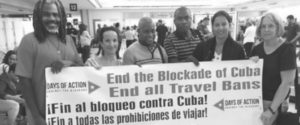
More serious than the travel ban is Trump’s enactment of Title 3 of the Helms-Burton Act (first passed under Bill Clinton). Helms-Burton already blocks Cuban goods from being imported into the US or many needed supplies and parts from the US from being exported to Cuba. Trump, however, has put into effect an especially onerous provision, never before imposed by prior presidents, which retroactively declares that properties of Cubans who later left their country and became US citizens, is US property. This blatantly extraterritorial bill authorizes lawsuits by “gusanos” (right wing ex-Cubans) in US courts against third parties who use or develop such properties in Cuba. The Cubans point out correctly that they offered and paid compensation to all other countries for properties that were nationalized, but the right-wing Cubans and the US corporations declined to accept it, gambling that they could quickly overthrow the Cuban government. In that effort at “regime change,” the US and the right-wing Cuban terrorists it has bankrolled have failed dismally for 60 years, and the Cubans are proudly defiant of Trump’s latest efforts.
Since I returned, the US has expelled a number of Cuban diplomats from the United Nations prior to the international climate summit (at which the Cubans could have provided many lessons, including eco-agriculture not reliant on petro-chemical fertilizers, massive reforestation and other measures). Twitter also suddenly denied service to dozens of Cuban media outlets and accounts. Trump has also impacted shipments of oil and other supplies to Cuba through his sanctions and now embargo/blockade against Venezuela. These violations of Cuban (and Venezuelan) sovereignty and dignity are artifacts of colonialism and Cold-War relics that must be opposed and overturned here in the US. The Cubans (and Venezuelans) have made it clear that they will persevere with their revolutions, and defend their countries and their new way of life, no matter what the US throws at them.

An example of how preposterous these measures are is that the Helms-Burton Act demands that Cuba hold “free” elections in which neither Fidel nor Raul Castro would be allowed to run, as a precondition for lifting the sanctions and embargo. Of course, Fidel Castro has passed away, Raul Castro has retired, and Cuba has a new president, born since the Revolution, elected in an extensive democratic process that also revised the Cuban constitution after prolonged consultation with various constituencies (geographic and sectoral, such as labor, farmers, students and women). Elections are non-partisan (the Cuban Communist Party is not an electoral party).
Let me describe several interactions and experiences I had that make clear why it is that Trump and US imperialism hate and fear Cuba so much.
RACISM & RACE RELATIONS IN CUBA
At the Julio Antonio Mella international solidarity camp outside Havana (named for another martyr of the Revolution), we were visited by three Afro-Cubans, active in cultural, political and academic affairs. They spoke about race and racism in Cuba, and made it clear that — as in many other respects — they do not claim to be a paradise or perfect, but a society waging a successful but ongoing struggle for liberation.
They identified racial prejudice (personal bias and animosity), racial discrimination (occasional or individual misuse of power to apply such prejudices in practice) and institutional racism (racialized economic and political power structures). They feel that they have outlawed and overcome the last of those, but continue to grapple with the first two. There is no more segregation or color line as existed in Cuba into the 1950s on their legacy of racial chattel slavery, which lasted longer even than in the US, or the role of US capital and US criminal cartels like the Mafia casinos in Cuba, but there are still personal prejudices, and they can sting. One person recounted that there is no longer institutional racism, but his mother was upset when he married a Black woman.
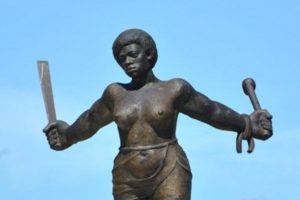
A statue of Carlotta Lucumí in Cuba. Carlotta was an enslaved African woman who led an uprising at the Triumvirato sugar mill in Cuba’s Matanzas Province. Her name was later given to Cuba’s 1980’s operation Black Carlota in Southern Africa, which culminated in the battle of Cuito Cuanavale that ultimately lead to the negotiations that ended Apartheid.–From Hood Communist
Overall, all Cubans regardless of skin tone or color identify with the strong African roots of their culture and society. At festivities and programs we attended, both light- and dark-skinned Cuban children often wore garb associated with African roots, and performed dances clearly related to African heritage. Unlike in the US, enslaved Africans historically in Cuba were able more generally to preserve their language and religion, and Yoruba rituals and orishas and the practice of Santeria are widespread.
I asked the historian after the presentation about the differences, if any, between incarceration in Cuba and the US, where in this country, incarceration is massive, highly racialized and used to legalize a new enslavement of Black and Brown prisoners.
He said that Cuba was completely different. Incarceration is a much smaller aspect of their society and today, the majority of the prisoners would be considered ‘white’ in US terms, because that’s who is committing frauds and other economic crimes. In addition, prisoners in Cuba are entitled to education, and when they work, receive the same pay as non-prisoners doing the same work!
LABOR RELATIONS & UNIONS IN CUBA
The next night, I went to the presentation by a representative of the Cuban trade union federation (which has existed since before the 1959 victory, and takes no funding from the state; unions are supported exclusively by member dues). I asked him if the unions had played a role in getting incarcerated workers equal pay for their work. He said that in the case of “inserted workers” — prisoners get work release during the day to work alongside other workers in various enterprises — there was some resistance from other workers to their presence. The unions saw it as their role to overcome this contradiction, and to work with their members to embrace the idea that prisoners needed to be re-socialized and re-integrated into society through gainful employment so that they could contribute to society and be more constructive once they were released.
Incidentally, the unions are organized on an industrial model. All workers in the health field, for example, are in the same union regardless of title or position – nurses, doctors, orderlies, radiologists, anestheticians, custodians all participate jointly and equally in a health care workers union. The same is true in the hospitality/tourism industry, the construction industry, etc. The union include over 90% of all the people working in state enterprises, and over 75% of the people working in private enterprises, such as hotels, restaurants, small retail establishments, barber and beauty shops, etc.
ECO-AGRICULTURE & REFORESTATION IN CUBA
A third example was the case of Las Terrazas, a community in what was described as a bio-preserve, a reforested area that was a site of eco-tourism. After the 1959 victory, the area, which had been virtually denuded of its hardwood trees by centuries of exploitation by Spain and the US, was chosen for development of a nature reserve. The residents, making a hard-scrabble living mainly by producing charcoal out of the remaining or fallen trees, were invited to join in the project and to come live in one of 11 communities that were simultaneously built in the area along with the reforestation project. They joke about a division between the “believers,” people who came in right away, and others, more skeptical, who waited to see if they made a go of it, but in fact the residents are now all united.
Rather than a pristine wilderness or forest primeval, the Cubans planted a mixture of the nearly extinct indigenous hardwoods along with fruit trees and other vegetation. They also carried out a careful and respectful development of a resort area along the cascading river, a hotel, and a series of pleasant, unobtrusive and communal housing developments in which people could live in greater harmony with their surroundings. The motto of the national eco-tourism agency is “We preserve nature so that we can share it.”

We also went to and worked at a number of organic fields and gardens. The manager of one such cooperative, where they grow organic vegetables and also raise bees for honey and rabbits for food showed us the waste-not, want-not approach they use. Weeds culled from the field feed the rabbit. Rabbit poop goes into worm beds along with other organic waste. The worms digest and the casting they produced is used to fertilize the soil and to start off little seedlings in small cups to transplant to the fields. Incidentally, the co-op manager introduced us to his daughter, who before reading a poem proudly declared that she had been conceived in a test-tube. Free in vitro fertilization services had been provided to her father and mother when they failed to conceive.
At a site described as using genetic engineering, we learned that they are not talking about GMOs, which they avoid in their organic agriculture. This was a facility using artificial insemination by select bulls, and embryo transplants from the select impregnated cows to other cows, to maximize the production of calves with strong genetic coding for maximum meat of milk production. They have created in this process hybrids that are able to flourish in Cuba’s tropical climate. As an example of what socialism means in practice, this facility was staffed by 7 people; it was part of a larger agricultural enterprise of about 500 people who raised or shipped the cattle, and grew and harvested local feed corn, fruit and vegetables. They in turn were providing healthy food to probably 10,000 people locally. This is another way Cuba is almost the exact reverse of the US, where wealth is extracted from tens of thousands and pumped upward to line the pockets of a greedy few. Primary producers on small or even mid-sized farms in the US are totally at the mercy of big agribusiness interests and the feed, seed, and chemical fertilizer companies.
VETERANS IN CUBA
Cuba has more than 350,000 veterans of combat military service, including people who were involved in clandestine urban activity and in the guerrilla war that culminated in the 1959 victory, those involved in repelling the CIA invasion at Playa Giron (known in the US as the Bay of Pigs) or dealing with other gusano terror attacks, and people who went on various military solidarity deployments to Africa, especially those that supported liberation struggles against South African apartheid-colonialism in Namibia and Angola.
We went to a meeting of a veterans association in one town. There we heard from, among others, Victor Dreke, dressed in a dashiki, a Black Cuban who had served in every one of the five areas of conflict.

He went to the Congo with Che Guevara after the CIA murder of Patrice Lumumba to assist the liberation forces struggling against US-led neo-colonialism. (Since I had just read about him in Che’s “after-action” report about that somewhat ill-fated effort, it was especially fascinating to meet him in person.)
He and others made clear that although such “combatientes” are respected and revered, and their sacrifices and contributions are honored, they do not receive anything other than what all Cubans get, because they are a combative people and all are sacrificing for the greater good. They receive medical attention as all Cubans do. Veterans do not get extra points on exams for employment or other privileges, because Cuban society is not organized around privilege and competition. Everyone is entitled to employment, housing, food, education and medical care as a human right. Coming from a society like the US, totally organized around privilege (whether it’s settler privilege, white privilege, male or cis privilege, class privilege), it is unbelievably refreshing and inspiring to see a society organized around human rights, human dignity and equality.

MEDICAL CARE IN CUBA
Cuba has some of the best medical care in the world. In response to the US embargo/blockade, they are developing their own pharmaceutical industry for export as a source of hard currency. They have developed a variety of vaccines for both human and animal diseases (for example, against swine fever, which the US introduced into Cuba in an act of biological warfare to try to destroy the pigs which many Cubans raise for food). They also have developed unique anti-cancer treatments and a treatment for people with diabetes who would otherwise lose feet or limbs to the disease. Diabetes-caused amputations and blindness are common in the US, especially among Black, indigenous and other poor people, and many of the amputations could be prevented if this medicine were available here. Cuba also trains, free of charge, medical personnel from countries all over the world, including the US, at the Latin American School of Medicine (ELAM by its Spanish initials), solely on the commitment that doctors so trained will work with poor and underserved people in their own country upon completion of their education. Among the free medical care Cuba provides is gender-reassignment surgery, and the Cenesex, a national institute for sex education, actively promotes LGBTQ equality and openness, as well as positive sexual hygiene for all people.
Shortly after my return, I heard from my brother-in-law that he was worrying about whether some oral surgery he needed would be covered by his medical insurance. I told him about visiting a “policlinic” in Cuba, an intermediate level medical facility between primary care doctors and nurses, who live in neighborhoods with the people they treat, and larger hospitals where more serious surgery and other treatments are performed. The policlinic had all sorts of specialists, including obstetrics, gynecology, radiology, pediatrics and well-baby care, and a complete dentistry office with hygienists, orthodontist, periodontal work, and a workshop where false teeth, bridges and implants were being made right on the premises. There were also classrooms for both general health workshops for the public and training for personnel who wanted to improve their skills or advance in the medical profession. Prominently displayed was a quote from Raul Castro about the approach cadres should take in identifying problems, proposing solutions and galvanizing and concentrating the will of the people in overcoming any difficulties or rectifying any errors.
This attitude of caring and sharing, of overcoming any obstacles, exemplifies what Cuban society as a whole and its people individually are striving to realize day to day, despite the privations that US imperialism and globalized capitalism subjects them to. They deserve our respect, our loving solidarity and our committed struggle to overturn and reverse the ceaseless US attacks on them and their ongoing revolution.
About a dozen of us from L.A. went to Cuba on this 50th Venceremos Brigade with over 150 others from around the country, and we are planning to build the Brigade regionally and step up solidarity work here in Los Angeles. If you are interested in getting involved, or want to learn more about how you can travel to Cuba, please get in touch. Call me at 323-636-7388 or email [email protected]. We are putting on a report back on Oct. 5 at 3 PM at Mercado La Paloma, 3655 S. Grand Ave in L.A. More info here:
https://www.facebook.com/events/492961484831119/
A number of us and others will be putting on a panel about Cuba and resisting the US blockade at the Left Coast Forum initially scheduled at Occidental College for Oct. 13 but postponed until further notice. Info here: https://leftcoastforum.org
